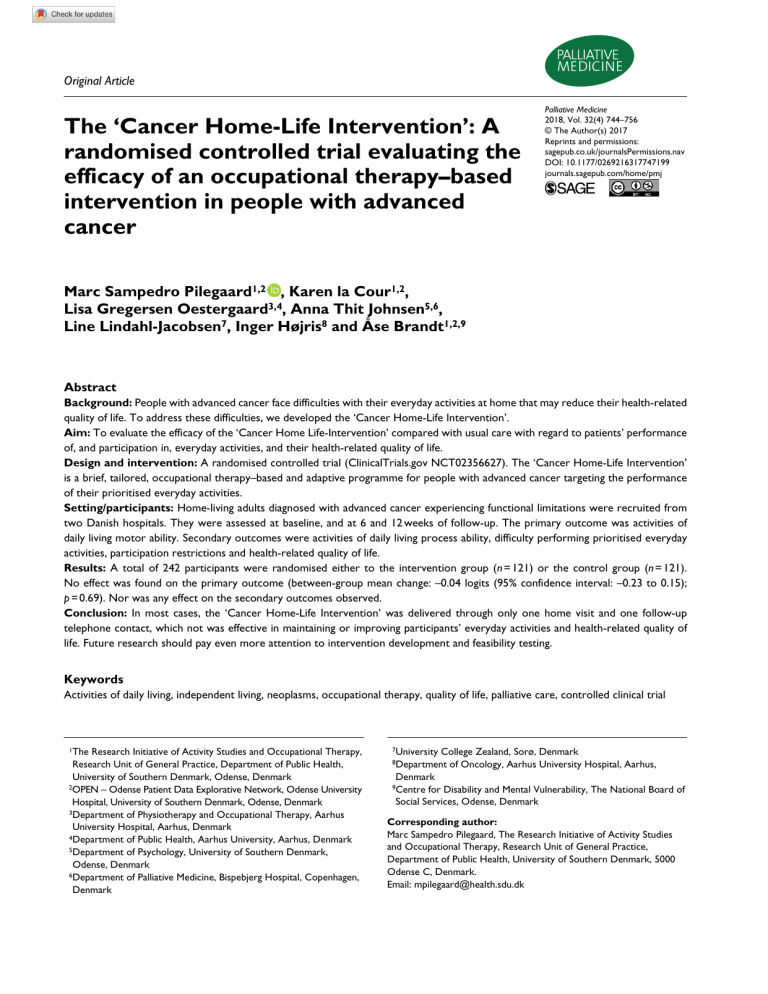
747199 research-article2017 PMJ0010.1177/0269216317747199Palliative MedicinePilegaard et al. Original Article The ‘Cancer Home-Life Intervention’: A randomised controlled trial evaluating the efficacy of an occupational therapy–based intervention in people with advanced cancer Palliative Medicine 2018, Vol. 32(4) 744­–756 © The Author(s) 2017 Reprints and permissions: sagepub.co.uk/journalsPermissions.nav https://doi.org/10.1177/0269216317747199 DOI: 10.1177/0269216317747199 journals.sagepub.com/home/pmj Marc Sampedro Pilegaard1,2 , Karen la Cour1,2, Lisa Gregersen Oestergaard3,4, Anna Thit Johnsen5,6, Line Lindahl-Jacobsen7, Inger Højris8 and Åse Brandt1,2,9 Abstract Background: People with advanced cancer face difficulties with their everyday activities at home that may reduce their health-related quality of life. To address these difficulties, we developed the ‘Cancer Home-Life Intervention’. Aim: To evaluate the efficacy of the ‘Cancer Home Life-Intervention’ compared with usual care with regard to patients’ performance of, and participation in, everyday activities, and their health-related quality of life. Design and intervention: A randomised controlled trial (ClinicalTrials.gov NCT02356627). The ‘Cancer Home-Life Intervention’ is a brief, tailored, occupational therapy–based and adaptive programme for people with advanced cancer targeting the performance of their prioritised everyday activities. Setting/participants: Home-living adults diagnosed with advanced cancer experiencing functional limitations were recruited from two Danish hospitals. They were assessed at baseline, and at 6 and 12 weeks of follow-up. The primary outcome was activities of daily living motor ability. Secondary outcomes were activities of daily living process ability, difficulty performing prioritised everyday activities, participation restrictions and health-related quality of life. Results: A total of 242 participants were randomised either to the intervention group (n = 121) or the control group (n = 121). No effect was found on the primary outcome (between-group mean change: –0.04 logits (95% confidence interval: –0.23 to 0.15); p = 0.69). Nor was any effect on the secondary outcomes observed. Conclusion: In most cases, the ‘Cancer Home-Life Intervention’ was delivered through only one home visit and one follow-up telephone contact, which not was effective in maintaining or improving participants’ everyday activities and health-related quality of life. Future research should pay even more attention to intervention development and feasibility testing. Keywords Activities of daily living, independent living, neoplasms, occupational therapy, quality of life, palliative care, controlled clinical trial 1The Research Initiative of Activity Studies and Occupational Therapy, Research Unit of General Practice, Department of Public Health, University of Southern Denmark, Odense, Denmark 2OPEN – Odense Patient Data Explorative Network, Odense University Hospital, University of Southern Denmark, Odense, Denmark 3Department of Physiotherapy and Occupational Therapy, Aarhus University Hospital, Aarhus, Denmark 4Department of Public Health, Aarhus University, Aarhus, Denmark 5Department of Psychology, University of Southern Denmark, Odense, Denmark 6Department of Palliative Medicine, Bispebjerg Hospital, Copenhagen, Denmark 7University College Zealand, Sorø, Denmark of Oncology, Aarhus University Hospital, Aarhus, 8Department Denmark ­ 9C entre for Disability and Mental Vulnerability, The National Board of Social Services, Odense, Denmark Corresponding author: Marc Sampedro Pilegaard, The Research Initiative of Activity Studies and Occupational Therapy, Research Unit of General Practice, Department of Public Health, University of Southern Denmark, 5000 Odense C, Denmark. Email: [email protected] Pilegaard et al. 745 What is already known about the topic? •• Many people with advanced cancer want to stay at home for as long as possible. •• Research shows that people with advanced cancer have difficulties performing and participating in everyday activities at home, and this may reduce their health-related quality of life (HRQoL). •• Only two pilot studies and an underpowered randomised controlled trial (RCT) have so far investigated the efficacy of occupational therapy–based (OT-based) interventions that support people with advanced cancer in performing and participating in everyday activities. What this paper adds? •• It was feasible to conduct a full-scale RCT for people with advanced cancer. •• The majority of the participants wanted and needed OT-based interventions that supported their everyday activities at home. •• We found no effect of the ‘Cancer Home-Life Intervention’ on activities of daily living (ADL) performance, difficulty performing prioritised everyday activities, autonomy and participation, or HRQoL. Implications for practice, theory or policy •• This is the first full-scale, sufficiently powered RCT to investigate the efficacy of an OT-based intervention in people with advanced cancer. •• Future RCTs evaluating efficacy of OT-based interventions in this population require even more attention to intervention development and feasibility testing. •• Future studies need to consider if patients selected for their studies should have more severe functional limitations than was the case in our study and if the intervention is relevant to patients. Introduction More people live longer with advanced cancer,1,2 and many of them want to stay at home for as long as possible.3,4 Research shows that most people with advanced cancer have difficulties performing and participating in everyday activities,5–10 which can affect their ability to stay at home and in turn reduce their health-related quality of life (HRQoL).11 Everyday activities refer to everything people do in daily life, like self-care and housework (activities of daily living (ADL)), work and leisure,12 with ADL being essential for maintaining independent living.13 Several qualitative studies emphasise that maintaining everyday activities and independence is an important priority for people with advanced cancer.14–18 However, Cheville et al.5 showed that more than 43% of women with metastatic breast cancer (N = 163) had difficulties performing ADL. Rainbird et al.10 revealed that 10%–30% of people with advanced cancer (N = 246) needed help with housework and preparing meals, 31% feared losing their independence and 40% were frustrated by being unable to participate in the activities they used to do previously. This resonates with a study by Johnsen et al.6 where 29% (N = 901) of people with advanced cancer did not receive the help they need concerning ADL. Similarly, Wæhrens et al.8 found that among people with advanced cancer, 53% (N = 136) had an observed ADL performance level requiring assistance to perform ADL and prioritised everyday activity problems mainly within mobility and domestic life.9 Thus, to support people with advanced cancer in living their lives as fully as possible, palliative care must also focus on enabling the patients’ everyday activities. A growing body of rehabilitation research on people with advanced cancer demonstrates effects on function and independence.19–26 These studies are largely exercisebased interventions.22–26 Occupational therapy–based (OT-based) interventions bring a different approach to existing palliative care interventions by intervening more directly on the target population’s everyday activity problems.27 A key principle underpinning most OT-based interventions is a person-centred approach where the interventions are tailored to patient’s priorities,27 which is in accordance with palliative care principles.28 To our knowledge, only two pilot randomised controlled trials (RCT)29,30 and one underpowered full-scale RCT31 have investigated OT-based interventions in people with advanced cancer. All three studies29–31 included adaptive interventions delivered by OTs, that is, interventions that include intrinsic changes, like change of habits and behaviour, and/or extrinsic changes, for example, provision of assistive technology and home modification.32 Overall, the studies29–31 showed that delivering an adaptive intervention focused on everyday activities for people with advanced cancer was feasible, although two of the studies had significant problems with recruitment and attrition.30,31 Due to the limited evidence of OT-based interventions in 746 people with advanced cancer, we developed the ‘Cancer Home-Life Intervention’.12 This study evaluates the efficacy of the ‘Cancer HomeLife Intervention’ and usual care compared with usual care alone in people with advanced cancer living at home in relation to ADL performance, difficulty performing prioritised everyday activities, autonomy and participation, and HRQoL. Methods Trial design This parallel group, superiority RCT with balanced randomisation (1:1) consecutively recruited participants from oncology units at Aarhus University Hospital (AUH), Denmark, and Odense University Hospital (OUH), Denmark, from February 2015 to October 2016. The Ethics Committee decided that no approval was required for this study (S-20122000-96). The study was approved by the Danish Data Protection Agency (FN 215-57-0008) and registered at ClinicalTrials.gov (NCT02356627). A previous article describes the details of the protocol.12 Participants Eligible participants were home-living adults (⩾18 years) diagnosed with advanced cancer by their responsible oncologist, had a World Health Organization (WHO) Performance Status (PS) 1–2 (see Appendix 1)33 and lived at home or in sheltered living within a maximum radius of 60 km from AUH or on the island of Funen. Ineligible participants were living in a nursing home or hospice, were cognitively impaired or had insufficient Danish language skills. The enrolled participants provided written informed consent. Intervention and control The ‘Cancer Home-Life Intervention’ is a tailored, OT-based, adaptive programme for people with advanced cancer delivered by OTs. It aims to enable people to perform and participate in the everyday activities at home that they prioritise but have difficulties performing (e.g. ADL, leisure, social activities) through application of one or more of the six components (Table 1), with component 1 being mandatory. The rationale of the intervention is to compensate for their functional limitations by providing the participant with adaptive strategies that have the potential to give people more energy to perform and participate in the everyday activities they prioritise. The adaptive components include intrinsic and extrinsic changes, like supporting them to prioritise time and to divide activities into smaller parts, teaching them strategies to use their body in a more efficient and safe manner, and providing Palliative Medicine 32(4) assistive technology and home modifications. All components are delivered through instruction in and practice of the selected strategies. Each participant is offered 1–3 face-to-face home visits lasting max 120 min and 1–3 telephone contacts after the first intervention visit to reinforce intervention strategy use and resolve any emerging problems. The tailoring (which components and the number of components and home visits) is based on the participant’s type of activity problems. For details, see the protocol and Table 1.12 Usual care comprised home-care, palliative care and/or rehabilitation that sometimes also involved OT as provided by the participants’ home municipality. Procedures Six intervention occupational therapists (I-OTs) performed the intervention. The I-OTs participated in a one-day workshop where they trained in performing the intervention with time to discuss the different parts of the intervention with the developers in order to standardise the delivery of the intervention. The I-OTs participated in three meetings during the study period to enhance the fidelity of the intervention. During delivery, the I-OTs monitored their fidelity to the intervention manual by reporting which components they provided to each participant.12 Eight trained data-collection occupational therapists (D-OTs) collected the data from February 2015 to December 2016. They collected baseline (T1) and 12-week (T3) data in the participants’ homes. Six-week (T2) data were collected using a postal questionnaire and telephone interview. Outcome measures ADL performance. The Assessment of Motor and Process Skills (AMPS) is an observation-based instrument measuring the observed quality of ADL task performance. It has two domains: ADL motor ability and ADL process ability. Higher positive measures represent better ADL performance. Measures of ⩾0.3 logits on both indicate a clinically relevant change. ADL motor ability measures above 2.0 logits and ADL process ability measures above 1.0 logits represent competent ADL performance (no physical effort, efficient, safe and independent). The AMPS has demonstrated sound psychometric properties in terms of validity and reliability among people with cancer34,35 and sensitivity to change in other diagnostic groups.13 Difficulties performing the participants’ prioritised everyday activities. The Individually Prioritised Problem Assessment (IPPA) is a generic, structured interview–based instrument that is used to identify participants’ prioritised everyday activities and the ease/difficulty participants encounter when performing them.36 The participants prioritise up to seven activity problems and rate the 747 Pilegaard et al. Table 1. Description of the ‘Cancer Home-Life Intervention’. Intervention features Intensity and content Setting Format Intervention provider Number of home visits Intervention period Time per visit Telephone follow-up Mandatory component Component 1 Participant’s home Individual Occupational therapist 1–3 ⩽3 weeks 60–120 min 1–3 Optional components Component 2 Component 3 Component 4 Component 5 Component 6 Initial interview Identify prioritised everyday activity problems in the home environment. The I-OT and the participant schedule an intervention plan together.They select which of the five optional components that should be included, tailoring the intervention to the participant’s needs with their prioritised everyday activities. Prioritisation of resources, energy and activities Instructing participant in energy conservation techniques, talking about time to rest during the day and delegating activities to family members or other people, for instance, so that participants can perform and participate in their prioritised everyday activities. Adaptation of activities Instructing participant in how to perform prioritised everyday activities in alternative ways according to symptom management, for example, by working in a seated position instead of standing, splitting tasks into actions, reordering actions and asking for assistance. Adaptation of posture and seating positioning Instructing participants and practising seated positioning and ergonomics when performing their prioritised everyday activities, for example, lifting techniques, how to obtain a good seating/standing position during activity and how to obtain a good resting position in bed or other places. Provision of assistive technology Selecting assistive devices for participants and instructing and practicing in using them when performing prioritised everyday activities, for example, mobility devices, devices for gardening, devices for handling cold objects. Modification of the physical home environment Providing home safety and home modification, for example, rearranging furniture or setting up handrails, and ensuring home safety. I-OT: intervention occupational therapist. importance and difficulty of these problems. In this study, prioritised activity problems were limited to those in the home environment. IPPA scores range from 1 to 25, with a higher score indicating a greater degree of difficulty performing prioritised everyday activities. The IPPA has been found to be a responsive and valid instrument in elderly people.37,38 Autonomy and participation. The Danish version (IPA-DK) of the Impact on Participation and Autonomy Questionnaire (IPAQ) is a generic questionnaire used to identify personperceived participation restrictions. It has five domains.39 We used autonomy indoors, family roles and social relations subscales with scores ranging from 0–4, with 0 being no participation restrictions and 4 being perceived severe participation restrictions. The scores were dichotomised into no perceived restrictions (score 0 and 1) and perceived restrictions (scores 2, 3 and 4). The IPA-DK and IPAQ have demonstrated acceptable psychometric properties regarding validity, reliability and sensitivity.40–43 HRQoL. The European Organisation for Research and Treatment of Cancer Quality-of-Life Questionnaire Core 30 (EORTC QLQ C-30) is a cancer-specific questionnaire assessing HRQoL and consists of 15 scales.44 We used the global health status/Quality of Life scale as an overall measure of HRQoL, with scores ranging from 0 to 100, where higher scores indicate better HRQoL.44 The EORTC QLQ C-30 has been found to be a responsive, valid and reliable instrument among people with advanced cancer.45,46 Primary outcome •• Change in ADL motor ability from T1–T3 measured with the AMPS.13 748 Palliative Medicine 32(4) Secondary outcomes •• Change in ADL process ability from T1–T3 measured with the AMPS;13 •• Change in difficulties performing prioritised everyday activities from T1–T2 and from T1–T3 assessed with the IPPA;36 •• Probability of no perceived participation restrictions within the domains autonomy indoors, family role and social relations at T2 and T3 assessed by the IPA-DK;39 •• Change in HRQoL from T1–T2 and from T1–T3 assessed by the EORTC QLQ C-30.44 Sample size To identify a clinically relevant between-group change of 0.3 logits on the ADL motor ability, we needed to recruit 272 participants with an expected attrition of 32% (N = 184 would provide 80% power). Alpha was 5% and the standard deviation (SD) 0.727.12 Randomisation and masking After T1, the D-OTs randomised the participants to one of the two groups using online computer-generated randomisation with a fixed block size prepared by the Odense Patient Data Explorative Network that had no other study involvement. Analyses were performed masked for the group allocation. The D-OTs were masked when collecting the outcome measures. Analyses Descriptive data are presented with mean values and SD, median and interquartile range (IQR), or number and percent. For quantitative outcomes (AMPS, IPPA and EORTC QLQ C-30), change in the intervention group was compared with change in the control group47 using multiple linear regression analyses. Analyses were adjusted for hospital. Logistic regression analysis was performed comparing the odds ratio (OR) of not having perceived participation restrictions within the three IPA-DK domains. Betweengroup change and the OR were presented with 95% confidence intervals (CI). Primary analyses were performed as complete case analysis, excluding participants with missing outcome measure values and with invalid AMPS data. Data were analysed according to original group allocation; and two sensitivity analyses were conducted to examine the robustness of the primary analyses: 1. Linear regression analysis adjusted for unbalanced variables at T1 between the groups.12 2. Mixed linear models to investigate change over time and between-group differences for quantitative outcomes. p values ⩽0.05 were considered statistically significant. Analyses were performed using STATA 14. Results Participants Between 16 January 2015 and 28 September 2016, 522 people were invited to participate (Figure 1). Measures were completed at T1 by 242 participants who were randomised to intervention (n = 121) or control (n = 121). No significant differences for age (p = 0.29), gender (p = 0.55), WHO PS (p = 0.65) and primary cancer type (p = 0.24) were found between participants and those who declined participation. Attrition was almost similar (intervention: 8.3% (T2) and 9.9% (T3)) versus control: 7.4% (T2) and 12.4% (T3)) with death and illness being the main causes. T3 (AMPS: n = 1 invalid) was completed by 191 participants (Figure 1). The number of people included was sufficient to reach the calculated sample size (N = 184). The mean age for the study population was 67.91, slightly more women than men participated (124 (51.2%)), and the majority of the participants were living with a partner (167 (68.9%)). The most common primary cancer types were gastrointestinal (74 (30.6%)), lung (48 (19.8%)) and breast (37 (15.3%)). The mean ADL motor ability was 1.13 logits, namely, far below the competence cut-off (<2.0 logits), indicating safety risk and/or need for assistance during ADL performance. The mean ADL process ability was 0.84 logits, which is just below the competence cut-off (<1.0 logits). Participants encountered difficulties performing their prioritised everyday activities (mean score 14.26 on 1–25 scale) and had reduced HRQoL (mean score 58.51 on 0–100 scale). They reported almost no perceived participation restrictions within the three subdomains of the IPA-DK (Table 2). We found the two groups comparable at baseline, but did see slightly more women in the control group. We therefore adjusted for gender in the sensitivity analyses. Delivered interventions Eight participants declined the intervention (6.61%). The remainder of the intervention group received the mandatory component 1 (113 (93.4%)). The median number of delivered components was three. A total of 36 participants (29.8%) received more than one home visit, and 62 participants (51.2%) received at least one follow-up telephone contact (Table 3). Agreement between the D-OTs’ estimate of group allocation and the actual allocation was 749 Pilegaard et al. Figure 1. Flow chart 66.2% (k = 0.32 (95% CI: 0.21–0.44)), indicating weak agreement. Five participants (4.1%) in the control group received some element of OT from their local municipality during T1–T2 and two participants (1.7%) from T2–T3. The primary outcome ADL motor ability decreased in both groups during T1–T3 (Figure 2(a)). The within-group change was small (intervention group: –0.14 logits (95% CI: –0.27 to 0.00)) (control group: –0.10 logits (95 CI: –0.24 to 0.05); Table 4) with the change in the intervention group being borderline significant. We observed no statistically significant effect of the ‘Cancer Home-Life Intervention’ on the primary outcome from T1–T3 (between-group mean change in ADL motor ability: –0.04 logits (95% CI: –0.23 to 0.15); p = 0.69; Table 4). Sensitivity analyses did not change the results. Secondary outcomes Both groups’ ADL process ability decreased during T1– T3 (Figure 2(b)). The two groups experienced statistically less difficulty performing their prioritised everyday activities over time (Table 4). Small within-group change was found concerning HRQoL, decreasing during T1–T2 and increasing during the last follow-up (Figure 2(d)). The probability of no perceived participation restrictions was high for both groups at both follow-ups. No statistically significant between-group differences were found (Table 4). Sensitivity analyses confirmed the results of no intervention effect. Discussion This RCT evaluated the efficacy of the ‘Cancer Home-Life Intervention’ compared with usual care alone in people with advanced cancer living at home. We found no 750 Palliative Medicine 32(4) Table 2. Participants’ baseline characteristics (N = 242). Age (years), mean (SD) Women, n (%) Hospital, n (%) AUH OUH Living alone, n (%) Missing, n (%) Type of residence, n (%) House Apartment Other Missing, n (%) Education, n (%) ⩽10 years 11–12 years >13 years Missing, n (%) Comorbidities, n (%) 0 1–3 >3 Missing, n (%) Primary tumour site, n (%) Gastrointestinal Lung Breast Prostate Head and neck Bladder Gynaecological Other Missing, n (%) WHO Performance Status, n (%) 1 2 Missing, n (%) ADL motor ability (AMPS), mean (SD) a Below competence cut-off, n (%)b Missing, n (%) ADL process ability (AMPS), mean (SD)a Below competence cut-off, n (%)b Missing, n (%) IPPA mean score (SD)c,d Missing, n (%) Number of activity problems, n (%) 0 1–3 >3 Missing, n (%) HRQoL (QLQ-C30), mean (SD)e,f Missing, n (%) Study population (N = 242) Intervention group (n = 121) Control group (n = 121) 67.91 (9.00) 124 (51.2) 68.67 (8.64) 54 (44.6) 67.16 (9.32) 70 (57.9) 222 (91.7) 20 (8.3) 74 (30.7) 1 (0.4) 111 (91.7) 10 (8.3) 33 (27.5) 1 (0.8) 111 (91.7) 10 (8.3) 41 (33.9) 0 (0.00) 168 (69.7) 57 (23.7) 16 (6.6) 1 (0.4) 85 (70.8) 25 (20.8) 10 (8.3) 1 (0.8) 83 (68.6) 32 (26.5) 6 (5.0) 0 (0.00) 64 (26.7) 63 (26.3) 113 (47.1) 2 (0.8) 31 (25.8) 37 (30.8) 52 (43.3) 1 (0.8) 33 (27.5) 26 (21.7) 61 (50.8) 1 (0.8) 52 (21.5) 161 (66.5) 23 (9.5) 6 (2.5) 25 (21.6) 79 (68.1) 12 (10.3) 5 (4.1) 27 (22.5) 82 (68.3) 11 (9.2) 1 (0.8) 74 (30.6) 48 (19.8) 37 (15.3) 30 (12.4) 17 (7.0) 15 (6.2) 14 (5.8) 6 (2.5) 1 (0.4) 44 (36.4) 22 (18.2) 16 (13.2) 16 (13.2) 10 (8.3) 6 (5.0) 2 (1.2) 5 (4.1) 0 (0.0) 30 (24.8) 26 (21.5) 21 (17.4) 14 (11.6) 7 (5.8) 9 (7.4) 12 (9.9) 1 (0.8) 1 (0.8) 171 (71.0) 70 (29.1) 1 (0.4) 1.13 (0.59) 230 (95.4) 1 (0.4) 0.84 (0.39) 81 (67.5) 39 (32.5) 1 (0.8) 1.12 (0.58) 117 (97.5) 1 (0.8) 0.85 (0.39) 90 (74.4) 31 (25.6) 0 (0.0) 1.14 (0.59) 113 (93.4) 0 (0.0) 0.84 (0.38) 142 (58.9) 1 (0.4) 14.26 (4.06) 3 (1.2) 71 (59.2) 1 (0.8) 14.16 (3.65) 0 (0.0) 71 (58.7) 0 (0.0) 14.35 (4.45) 3 (3.3) 64 (26.6) 76 (31.5) 101 (41.9) 1 (0.4) 58.51 (21.98) 2 (0.8) 33 (27.5) 35 (29.2) 52 (43.3) 1 (0.8) 57.64 (22.7) 1 (0.8) 31 (25.6) 41 (33.9) 49 (40.5) 0 (0.0) 59.38 (21.4) 1 (0.8) (Continued) 751 Pilegaard et al. Table 2. (Continued) Study population (N = 242) Autonomy indoor (IPA-DK), median (IQR)g Missing, n (%) Family role (IPA-DK), median (IQR)g Missing, n (%) Social relations (IPA-DK), median (IQR)g Missing, n (%) Intervention group (n = 121) Control group (n = 121) 0 (0–1) 0 (0–1) 0 (0–1) 2 (0.8) 1 (0–2) 3 (1.2) 0 (0–1) 1 (0.8) 1 (0–2) 1 (0.8) 0 (0–1) 1 (0.8) 1 (0–2) 2 (1.7) 0 (0–0) 5 (2.1) 3 (2.5) 2 (1.7) SD: standard deviation; AUH: Aarhus University Hospital; OUH: Odense University Hospital; WHO: World Health Organization; ADL: activities of daily living; AMPS: Assessment of Motor and Process Skills; IPPA: Individually Prioritised Problem Assessment; HRQoL: health-related quality of life; QLQ-C30: European Organisation for Research and Treatment of Cancer Quality of life C-30; IPA-DK: The Danish Version (IPA-DK) of the Impact on Participation and Autonomy Questionnaire (IPAQ); IQR: interquartile range. aHigher positive measures represent a greater degree of ADL ability. bBelow competent cut-off on the ADL motor ability (<2.0 logits) and the ADL process ability (<1.0 logits). cThe IPPA score ranges from 1 to 25, with higher scores indicating a greater degree of difficulty performing prioritised everyday activities. dOnly includes participants with at least one prioritised activity problem (intervention group: n = 87 and control group: n = 90). eThe global health status/quality of life scale from the EORTC QLQ C-30 is used to assess HRQoL. fThe HRQoL ranges from 0 to 100, with higher scores indicating a greater degree of HRQoL. gThe IPA-DK ranges from 0 to 4, with 0 being no perceived participation restrictions and 4 being severe perceived participation restrictions. Table 3. Components from the ‘Cancer Home-Life Intervention’ delivered to the participants in the intervention group (N = 121)a and total number of home visits, telephone follow-up contacts and time. The ‘Cancer Home-Life Intervention’ Components given by the intervention occupational therapist, n (%) 1. Interview 113 (93.4) 2. Prioritise resources, energy and 73 (60.3) activities 3. Adaptation of activities 70 (57.9) 4. Adaptation of posture and seated 37 (30.6) positioning 5. Assistive technology 65 (53.7) 6. Modification of the physical home 11 (9.1) environment Number of components per participant, median (IQR) Number 3 (2–4) Home visits, n (%) First home visit 113 (93.4) Second home visit 32 (26.4) Third home visit 4 (3.3) Time, median minutes (IQR) First home visit 105 (90–120) Second home visit 45 (30–75) Third home visit 45 (22.5–75) Telephone follow-up, n (%) No follow-up telephone contact 13 (10.7) First follow-up telephone contact 62 (51.2) Second follow-up telephone contact 39 (32.2) Third follow-up telephone contact 7 (5.8) IQR: interquartile range. aEight participants did not want to receive the intervention. statistically significant effect of the OT-based intervention (Table 4). Overall, our trial demonstrates high internal validity with limited and equal attrition between the groups, blinded assessors, sufficient statistical power and successfully performed randomisation. Below we discuss several aspects that need to be considered before one hastily concludes that OT-based interventions has no effect in people with advanced cancer. Intervention intensity The delivered ‘Cancer Home-Life Intervention’ was tailored and adjusted to the participants. In this study, this resulted in the intervention mainly encompassing three components, most of which were used during one home visit (median minutes = 105) and one telephone contact over a 3-week time span (Table 3). One explanation for why the ‘Cancer Home-Life Intervention’ showed no effect in this study may be that the intensity of the intervention was too low. An important question in this respect is what is a minimum of OT-based intervention required to instil change. To our knowledge, no clear cut-off of the minimum intensity required to instil change exists.48 A systematic review49 found short-term effects on ADL and prioritised everyday activities of low intensity OT-based interventions in older people delivered over 2.5–6 months with a mean intensity varying from 0.8 to 3.4 intervention sessions per month.49 The literature on behavioural change would argue that one home visit and one telephone contact is not enough to change strategies and achieve change, as this requires more therapeutic support over longer periods 752 Palliative Medicine 32(4) Figure 2. Change over time and between-group differences. ADL=Activities of Daily Living; AMPS=Assessment of Motor and Process Skills; IPPA=Individually Prioritised Problem Assessment; HRQoL=Health-related Quality of Life; QLQ-C30=European Organisation for Research and Treatment of Cancer Quality of Life Questionnaire C-30. of time.50 However, a telephone-delivered problemsolving OT-based intervention by Hegel et al.29 lasted on average 106 min, and they found effect on function, HRQoL and emotional state. This amount of time almost equals the time used in our intervention. When we designed the trial, we decided that 1–3 visit would be enough – partly based on the trial by Hegel et al.29 Moreover, we had expected that most participants would receive more than one visit. However, based on our results and the knowledge of behaviour change theory,50 one may consider if we should have delivered the intervention over a longer period of time and increased the intensity. since our cross-sectional study gave us knowledge about relevant outcomes, and we had sufficient information for estimating sample size, recruitment and so on.12 Furthermore, we had explored the acceptability and usefulness of the intervention in four people with advanced cancer, which showed that they definitely would value such an intervention.12 Still, a full feasibility study could have given us important information about required intervention intensity and intervention relevance. Feasibility Many people with advanced cancer face serious difficulties with ADL,5,6,8,9 which motivated our choice of ADL as the primary trial outcome.8 However, they also experience difficulties in other areas at home, such as leisure and We did not conduct a full feasibility study before the trial as advocated by the Medical Research Council,51 Outcomes 753 Pilegaard et al. Table 4. Mean change in primary outcome and secondary outcomes from baseline (T1) to six- (T2) and 12-week follow-up (T3) and odds ratio for no perceived participation restrictions; complete case analysis. Outcomes n Intervention group Control group n Mean change AMPS ADL motor ability T1–T3a,b,c,d ADL process ability T1–T3a,b,c,d IPPA IPPA score T1–T2c,d,e IPPA score T1–T3c,d,e EORTC QLQ C-30 HRQoL T1–T2c,d,f,g HRQoL T1–T3c,d,f,g Outcomes Mean change p value 97 97 −0.14 (–0.27 to 0.00) −0.10 (–0.20 to –0.01) 94 94 −0.10 (–0.24 to 0.05) −0.04 (–0.14 to 0.06) −0.04 (–0.23 to 0.15) −0.06 (–0.20 to 0.07) 0.69 0.37 67 62 −1.27 (–2.01 to –0.53) −1.38 (–2.35 to –0.40) 65 63 −1.16 (–1.91 to –0.41) −1.03 (–2.00 to –0.05) −0.11 (–1.17 to 0.95) −0.35 (–1.71 to 1.01) 0.83 0.61 94 93 −1.40 (–5.49 to 2.68) 1.50 (–2.97 to 5.97) 93 90 −1.19 (–5.39 to 3.01) 3.11 (–1.52 to 7.74) −0.21 (–5.97 to 5.54) −1.61 (–7.95 to 4.73) 0.94 0.62 n Intervention group n Control group Odds ratio for no perceived participation restrictions (95% CI) p value Oddsj Oddsi IPA-DKh Autonomy Indoor T2 Autonomy Indoor T3 Family role T2 Family role T3 Social relations T2 Social relations T3 Between-group mean change (95% CI) 95 89 95 89 95 89 7.64 (4.07 to 14.32) 8.89 (4.46 to 17.71) 1.21 (0.81 to 1.81) 1.70 (1.10 to 2.61) 18.00 (7.31 to 44.30) 11.71 (5.41 to 25.34) 91 87 91 87 89 87 6.00 (3.36 to 10.79) 8.67 (4.35 to 17.28) 1.39 (0.92 to 2.12) 1.56 (1.01 to 2.40) 13.83 (6.04 to 31.68) 13.50 (5.89 to 30.94) 1.27 (0.54 to 3.02)j,k 1.03 (0.39 to 2.75)j,k 0.83 (0.46 to 1.50)j,k 1.08 (0.59 to 1.99)j,k 1.22 (0.35 to 4.21)j,k 0.86 (0.28 to 2.69)j,k 0.59 0.95 0.54 0.81 0.75 0.80 AMPS: Assessment of Motor and Process Skills; ADL: activities of daily living; IPPA: Individually Prioritised Problem Assessment; IPA-DK: The Danish Version (IPA-DK) of the Impact on Participation and Autonomy Questionnaire (IPAQ); EORTC QLQ-C30: European Organisation for Research and Treatment of Cancer Quality of Life Questionnaire C-30; HRQoL: Health-related Quality of Life. aHigher positive measures represent a greater degree of ADL ability. bExponential transformation of the difference between groups did not change the results. cMultiple linear regression adjusted for hospital. The estimates are shown in the table. dMultiple linear regression adding gender in the model did not change the results and are therefore not shown in table. eThe IPPA score ranges from 1 to 25, with higher scores indicating a greater degree of difficulty performing prioritised everyday activities. fThe global health status/quality of life scale from the EORTC QLQ C-30 is used to assess HRQoL. gThe HRQoL ranges from 0 to 100, with higher scores indicating a greater degree of HRQoL. hThe IPA-DK were dichotomised into ‘no perceived participation restrictions’ and ‘perceived participation restrictions’. iOdds for no perceived participation restrictions. jLogistic regression adjusted for hospital. The estimates are shown in the table. kLogistic regression adding gender in the model did not change the results and are therefore not shown in table. creative activities,7 which our intervention was also designed to solve. Selecting outcome measures that capture the essence of an intervention is challenging, especially in people with advanced cancer with complex and diverse needs.6 Outcome measures in palliative care need to be psychometrically robust and sensitive to capture change over time.52 Sensitivity to change is particularly important when evaluating intervention effect. We selected the AMPS as an ADL measure because it is highly sensitive13 and more sensitive in oncology patients than other tools.53 However, the ‘Cancer Home-Life Intervention’ targeted participants’ prioritised everyday activity problems which do not always include ADL. This could have affected the causal connection between the ‘Cancer Home-Life Intervention’ and the AMPS, which may have been too narrow in scope. Recruitment Recruiting the most relevant study population is another challenge. We may have included individuals without the most urgent need for the intervention since 26.6% of the participants reported no activity problems (Table 2). We cannot rule out that this may have biased the results towards the null value as these people probably received a smaller amount of interventions. Over two-thirds of the participants had a WHO PS1, meaning that we mostly recruited better functioning people with advanced cancer. People with WHO PS1 still have difficulties performing physically strenuous activities but may have less difficulties performing ADL. However, their ADL ability measured with the AMPS clearly indicated need of assistance to live in the community. Nevertheless, this issue raises the 754 Palliative Medicine 32(4) question whether we have identified the most appropriate participants for an OT-based intervention since so many had no prioritised activity problem. A solution could have been to use self-reported activity problems as an inclusion criterion. What this study adds This study is the first full-scale, adequately powered RCT investigating the efficacy of an OT-based intervention in people with advanced cancer.54,55 Our study demonstrates that it is feasible to conduct a full-scale RCT in this vulnerable group of people and that the majority of them want and need OT-based interventions that support their everyday activities at home. This underlines that even though our RCT produced no evidence supporting the benefits of the present OT-based intervention, research and clinical practice in palliative care still need to focus on how to enable everyday activities in people with advanced cancer, helping them to live their lives as fully as possible. Conclusion The ‘Cancer Home-Life Intervention’, delivered mostly through a single home visit and a single follow-up telephone contact, was not effective in maintaining or improving participants’ everyday activities and HRQoL. Future studies should pay even more attention to intervention development, minimal intervention ‘dose’ believed to make a change and feasibility testing. Acknowledgements The authors thank the participants, the employees from the hospitals and the OTs. They also thank our advisory board: Professor Malcolm Cutchin, Professor Anders Bonde Jensen, Professor Jens Søndergaard and Associate Professor Eva Ejlersen Wæhrens. Declaration of conflicting interests The author(s) declared no potential conflicts of interest with respect to the research, authorship and/or publication of this article. Funding The author(s) disclosed receipt of the following financial support for the research, authorship and/or publication of this article: The TrygFonden and the Danish Cancer Society (R53-A2783), the University of Southern Denmark, the Danish Association of Occupational Therapists (FF 2 14 – 3), and the Region of Southern Denmark (15/23775) funded the study. ORCID iD Marc Sampedro Pilegaard 410X https://orcid.org/0000-0001-6362- References 1. Hashim D, Boffetta P, La Vecchia C, et al. The global decrease in cancer mortality: trends and disparities. Ann Oncol 2016; 27(5): 926–933. 2. Coleman MP, Quaresma M, Berrino F, et al. Cancer survival in five continents: a worldwide population-based study (CONCORD). Lancet Oncol 2008; 9(8): 730–756. 3. Higginson IJ and Sen-Gupta GJA. Place of care in advanced cancer: a qualitative systematic literature review of patient preferences. J Palliat Med 2000; 3(3): 287–300. 4. Gomes B, Calanzani N, Gysels M, et al. Heterogeneity and changes in preferences for dying at home: a systematic review. BMC Palliat Care 2013; 12: 7. 5. Cheville AL, Troxel AB, Basford JR, et al. Prevalence and treatment patterns of physical impairments in patients with metastatic breast cancer. J Clin Oncol 2008; 26(16): 2621–2629. 6. Johnsen AT, Petersen MA, Pedersen L, et al. Do advanced cancer patients in Denmark receive the help they need? A nationally representative survey of the need related to 12 frequent symptoms/problems. Psychooncology 2013; 22(8): 1724–1730. 7. Peoples H, Brandt Å, Waehrens EE, et al. Managing occupations in everyday life for people with advanced cancer living at home. Scand J Occup Ther 2016; 24(1): 57–64. 8. Wæhrens EE, la Cour K and Brandt Å. The quality of ADL task performance based on self-report and observation in people living at home with cancer. In: 16th international congress of the world federation of occupational therapists, Yokohama, Japan, 18–21 June 2014. 9. Brandt Å, la Cour K and Wæhrens EE. Activity problems important to people with advanced cancer living at home. In: 16th international congress of the world federation of occupational therapists, Yokohama, Japan, 18–21 June 2014. 10. Rainbird K, Perkins J, Sanson-Fisher R, et al. The needs of patients with advanced, incurable cancer. Br J Cancer 2009; 101(5): 759–764. 11. Esbensen BA, Osterlind K and Hallberg IR. Quality of life of elderly persons with cancer: a 6-month follow-up. Scand J Caring Sci 2007; 21(2): 178–190. 12. Brandt A, Pilegaard MS, Oestergaard LG, et al. Effectiveness of the ‘Cancer Home-Life Intervention’ on everyday activities and quality of life in people with advanced cancer living at home: a randomised controlled trial and an economic evaluation. BMC Palliat Care 2016; 15: 10. 13. Fisher AG and Jones KB. Assessment of motor and process skills: development, standardization, and administration manual, vol. 2. 8th ed. Fort Collins, CO: Three Star Press, 2010. 14. Reeve J, Lloyd-Williams M, Payne S, et al. Revisiting biographical disruption: exploring individual embodied illness experience in people with terminal cancer. Health: 2010; 14(2): 178–195. 15. Carter H, Macleod R, Brander P, et al. Living with a terminal illness: patients’ priorities. J Adv Nurs 2004; 45(6): 611–620. 16. La Cour K, Johannessen H, Scient M, et al. Activity and meaning making in the everyday lives of people with advanced cancer. Palliat Support Care 2009; 7: 469–479. 17. Johnston B. Can self-care become an integrated part of end of life care? Implications for palliative nursing. Int J Palliat Nurs 2010; 16(5): 212–214. Pilegaard et al. 18. Cotterell P. Striving for independence: experiences and needs of service users with life-limiting conditions. J Adv Nurs 2008; 62(6): 665–673. 19. Zimmermann C, Swami N, Krzyzanowska M, et al. Early palliative care for patients with advanced cancer: a clusterrandomised controlled trial. Lancet Oncol 2014; 383: 1721– 1730. 20. Jones L, Fitzgerald G, Leurent B, et al. Rehabilitation in advanced, progressive, recurrent cancer: a randomized controlled trial. J Pain Symptom Manage 2013; 46(3): 315–325. 21. Gomes B, Calanzani N, Curiale V, et al. Effectiveness and cost-effectiveness of home palliative care services for adults with advanced illness and their caregivers. Cochrane Database Syst Rev 2013; 6: CD007760. 22. Oldervoll LM, Loge JH, Lydersen S, et al. Physical exercise for cancer patients with advanced disease: a randomised controlled trial. Oncologist 2011; 16: 1649–1657. 23. Henke CC, Cabri J, Fricke L, et al. Strength and endurance training in the treatment of lung cancer patients in stages IIIA/IIIB/IV. Support Care Cancer 2014; 22(1): 95–101. 24. Jensen W, Baumann FT, Stein A, et al. Exercise training in patients with advanced gastrointestinal cancer undergoing palliative chemotherapy: a pilot study. Support Care Cancer 2014; 22(7): 1797–1806. 25. Mayo NE, Moriello C, Scott SC, et al. Pedometer-facilitated walking intervention shows promising effectiveness for reducing cancer fatigue: a pilot randomised trial. Clin Rehabil 2014; 28(12): 1198–1209. 26. Van den Dungen IA, Verhagen CA, van der Graaf WT, et al. Feasibility and impact of a physical exercise program in patients with advanced cancer: a pilot study. J Palliat Med 2014; 17(10): 1091–1098. 27. Burkhardt A, Ivy M, Kannenberg KR, et al. The role of occupational therapy in end-of-life care. Am J Occup Ther 2011; 65: 66–75. 28. Twycross R. Introducing palliative care. 4th ed. Abingdon: Radcliffe Medical Press, 2003. 29. Hegel MT, Lyons KD, Hull JG, et al. Feasibility study of a randomized controlled trial of a telephone-delivered problem-solving-occupational therapy intervention to reduce participation restrictions in rural breast cancer survivors undergoing chemotherapy. Psychooncology 2011; 20(10): 1092–1101. 30. Harrison-Paul J and Drummond A. A randomised controlled trial of occupational therapy in oncology: challenges in conducting a pilot study. Br J Occup Ther 2006; 69(3): 130–133. 31. Lindahl-Jacobsen L. Occupational therapy for cancer patients – a randomised, controlled study. Phd Thesis, University of Southern Denmark, Odense, 2014. 32. Söderback I. International handbook of occupational therapy interventions. 2nd ed. Cham: Springer, 2015. 33. World Health Organization. World Health Organization (WHO) handbook for reporting results of cancer treatment. Geneva: World Health Organization, 1979, p. 45. 34. Gerber LH, Hoffman K, Chaudhry U, et al. Functional outcomes and life satisfaction in long-term survivors of pediatric sarcomas. Arch Phys Med Rehabil 2006; 87(12): 1611–1617. 755 35. Parks R, Rasch EK and Mansky PJ. Differences in activities of daily living performance between long-term pediatric sarcoma survivors and a matched comparison group on standardized testing. Pediatr Blood Cancer 2009; 53(4): 622–628. 36. Socialstyrelsen. Dansk IPPA: Et Redskab Til at Afdække Aktivitetsproblemer I Hverdagen Og Evaluere Indsatser – manual. Report, Socialstyrelsen, Stockholm, 2013. 37. Wessels R, De Witte L, Andrich R, et al. IPPA, a user-centred approach to assess effectiveness of assistive technology provision. Technol Disabil 2000; 13(1): 105–115. 38. Wessels R, Persson J, Lorentsen Ø, et al. IPPA: individually prioritised problem assessment. Technol Disabil 2002; 14(3): 141–145. 39. Ghaziani E. Manual til den danske version af impact on participation and autonomy questionnaire (IPA-DK). Report, Bispebjerg Hospital, Copenhagen, 2013. 40. Kersten P, Cardol M, George S, et al. Validity of the impact on participation and autonomy questionnaire: a comparison between two countries. Disabil Rehabil 2007; 29(19): 1502–1509. 41. Cardol M, de Haan RJ, de Jong BA, et al. Psychometric properties of the impact on participation and autonomy questionnaire. Arch Phys Med Rehabil 2001; 82(2): 210– 216. 42. Cardol MBA, van den Bos GA and de Jong BA. Responsiveness of the impact on participation and autonomy questionnaire. Arch Phys Med Rehabil 2002; 83: 1524– 1529. 43. Ghaziani E, Krogh AG and Lund H. Developing a Danish version of the ‘impact on participation and autonomy questionnaire’. Scand J Occup Ther 2013; 20(3): 190–200. 44. Fayers PM, Aaronson NK, Bjordal K, et al. The EORTC QLQ-C30 scoring manual. 3rd ed. Brussels: European Organisation for Research and Treatment of Cancer, 2001. 45. Groenvold M, Klee MC and Sprangers MA. Validation of the EORTC QLQ-C30 quality of life questionnaire through combined qualitative and quantitative assessment of patient-observer agreement. J Clin Epidemiol 1997; 50(4): 441–450. 46. Kaasa S, Bjordal K, Aaronson N, et al. The EORTC core quality of life questionnaire (QLQ-C30): validity and reliability when analysed with patients treated with palliative radiotherapy. Eur J Cancer 1995; 31(13–14): 2260–2263. 47. Vickers AJ and Altman DG. Analysing controlled trials with baseline and follow up measurements. BMJ 2001; 323: 1123–1124. 48. Fritz H and Cutchin MP. Integrating the science of habit: opportunities for occupational therapy. OTJR 2016; 36(2): 92–98. 49. Nielsen TL, Petersen KS, Nielsen CV, et al. What are the short-term and long-term effects of occupation-focused and occupation-based occupational therapy in the home on older adults’ occupational performance? A systematic review. Scand J Occup Ther 2017; 24: 235–248. 50. Kwasnicka D, Dombrowski SU, White M, et al. Theoretical explanations for maintenance of behaviour change: a systematic review of behaviour theories. Health Psychol Rev 2016; 10(3): 277–296. 756 51. Craig P, Dieppe P, Macintyre S, et al. Developing and evaluating complex interventions: new guidance. Report, Medical Research Council, Swindon, 2008. 52. Evans JC, Benalia H, Preston NJ, et al. The selection and use of outcome measures in palliative and end-of-life care research: the MORECare international consensus workshop. J Pain Symptom Manage 2013; 46(6): 925–937. 53. Choo SX, Stratford P, Richardson J, et al. Comparison of the sensitivity to change of the functional independence measure with the assessment of motor and process skills within different rehabilitation populations. Disabil Rehabil. Epub ahead of print 10 September 2017. DOI: 101080/09638288.2017.1375033. 54. Hunter EG, Gibson RW, Arbesman M, et al. Systematic review of occupational therapy and adult cancer rehabilitation: part 1. Impact of physical activity and symptom management interventions. Am J Occup Ther 2017; 71(2): 7102100030. 55. Hunter EG, Gibson RW, Arbesman M, et al. Systematic review of occupational therapy and adult cancer rehabilitation: part 2. Impact of multidisciplinary rehabilitation Palliative Medicine 32(4) and psychosocial, sexuality, and return-to-work interventions. Am J Occup Ther 2017; 71(2): 7102100040. Appendix 1. Description of the World Health Organization performance status. Grade Explanation of activity 0 Fully active, able to carry on all pre-disease performance without restriction Restricted in physically strenuous activity but ambulatory and able to carry out work of a light or sedentary nature, for example, light housework, office work Ambulatory and capable of all self-care but unable to carry out any work activities. Up and about more than 50% of waking hours Capable of only limited self-care, confined to bed or chair more than 50% of waking hours Completely disabled. Cannot carry on any self-care. Totally confined to bed or chair Dead 1 2 3 4 5
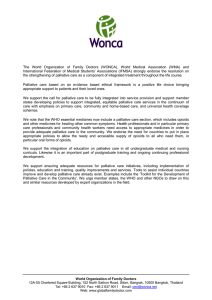
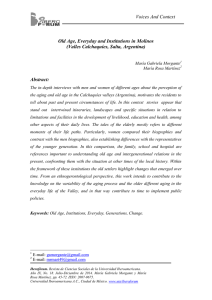
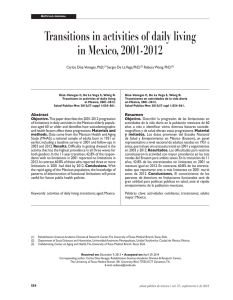

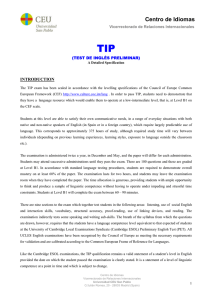
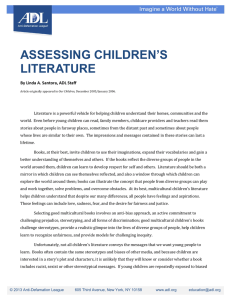
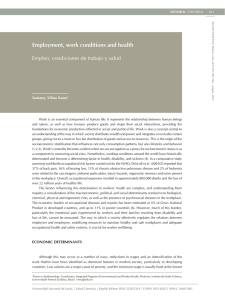
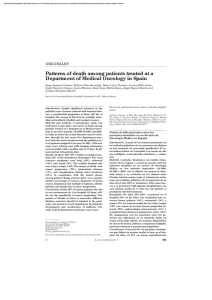
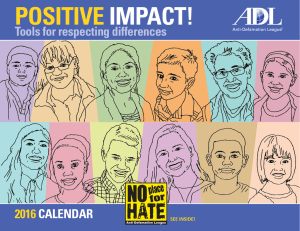
![Rev [insert date]](http://s2.studylib.es/store/data/005318471_1-149f1fbef3b80e5a6b8c489244356104-300x300.png)